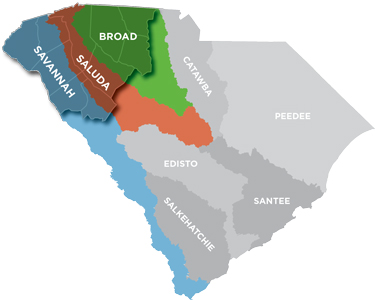How to safeguard water — naturally and cost-effectively
November 9th, 2022
By Erika Hollis
This is an excerpt from the Fall/Winter 2022-2023 issue of the Upstate Advocate, Upstate Forever's twice-yearly publication. To read a digital copy of the complete publication, please click here.
Part of our work at Upstate Forever is communicating the pivotal relationships between our natural resources and our daily lives. We strive to show how important access to green space is for quality of life, how smart land use practices prevent sprawl, how land conservation protects our most precious natural assets, and — perhaps the one facet of our work taken most for granted — how clean water drives every aspect of our lives.
Clean water is not only crucial to sustaining our bodies and environment, it is also fundamental in a successful economy, which could not function without water. As our region grows and develops, it is even more critical to use water in a sustainable way, and we can do that by protecting our precious watersheds.
Protecting watersheds
 A watershed is an area of land in which all rivers, lakes, and streams drain to a single common point. In the Upstate, all of our small rivers, creeks, and streams, which function as mini watersheds, drain to our larger watersheds in one of three river basins: the Broad, Saluda, and Savannah (see map).
A watershed is an area of land in which all rivers, lakes, and streams drain to a single common point. In the Upstate, all of our small rivers, creeks, and streams, which function as mini watersheds, drain to our larger watersheds in one of three river basins: the Broad, Saluda, and Savannah (see map).
When the lands within a watershed are protected and properly managed, it helps maintain water quality, and that quality supports nearly everything in our economy. If we invest in protecting and maintaining watersheds, then costs for water treatment and flooding drop dramatically and recreation income, property values, and business profits increase.
Preventing Flooding
Every year in the United States, floods cause an average of $8 billion in damage. The SC Emergency Management Division reported that after the historic floods that impacted Columbia in 2015, South Carolinian taxpayers absorbed $114 million of the $1 billion worth of property and infrastructure damage and clean-up.
The most effective way to combat these costs is to increase protection of ecosystems, meaning water sources and their surrounding forests, so they can help mitigate a flood’s impact. A study by The Nature Conservancy found that the benefits of protecting ecosystems to avoid future flood damages were at least five times the cost, meaning every $1 invested in protections returned at least $5 in savings.
Lowering Costs
Similar savings are possible with water treatment costs when we protect our watersheds. In the Upstate, every $1 spent on land protection — those forests that surround rivers and streams in a watershed — saves $27 on water treatment costs, according to a study conducted by The Trust for Public Land. These tracts of forest around waterways are called riparian buffers, and they are the most cost-effective way to protect drinking water quality.
When lands around waterways are threatened or irresponsibly developed, storm runoff increases, giving it more opportunity to pick up natural and man-made pollutants that flow into the nearest waterway. This, in turn, means more costs for water treatment. But, according to the EPA, if 50% of a forested watershed is protected, then the annual cost to treat 22 million gallons of water per day is around $370,000. When that forested watershed is reduced to only 10%, the cost for that same 22 million gallons per day soars to over $923,450.

Supporting the local economy
All that money saved through watershed protection can be funneled into the economy through sustainable means as well. We know that people like to live near healthy, clean water sources. In the Upstate, we have an abundance of lakes and rivers at our disposal, and property values around these bodies of water increase when the water is clean and properly maintained. In addition to increasing property values, revenues for adjacent retail and commercial businesses increase, too.
Outdoor recreation on and around bodies of water in South Carolina accounts for much of the economic benefits we see thanks to clean water from protected watersheds. The Outdoor Industry Association reports that the recreation sector generates $16.3 billion in consumer spending annually. The outdoor infrastructure that accompanies recreation attracts employers and active workforces to the region, which encourages the community to thrive economically and socially.
In fact, without clean, reliable water sources, 20% of the US economy would grind to a halt, and that would jeopardize $33.4 billion and 218,719 jobs contributed by the natural resource-based sections of South Carolina’s economy (as calculated by the SC Department of Natural Resources).
How to help
The economic contributions made by healthy watersheds cannot be overstated. They provide local economic benefits and maintain quality of life for generations to come. As a private citizen, you can help safeguard our water by monitoring your local waterways through SC’s Adopt-a-Stream program or by keeping a log of what’s happening in your local creek, river, wetland, or lake.
You can also contact your state and local officials to let them know you care about the watersheds in your area. Pay close attention to other local city and county council issues, too, because what happens to land in your area inevitably impacts the water where you live.
Erika Hollis is the Clean Water Director for Upstate Forever. You can email her at ehollis@upstateforever.org.
Want to stay in the loop on water-related news and issues? Sign up for our e-newsletter, The Water Log, at upstateforever.org/email.

